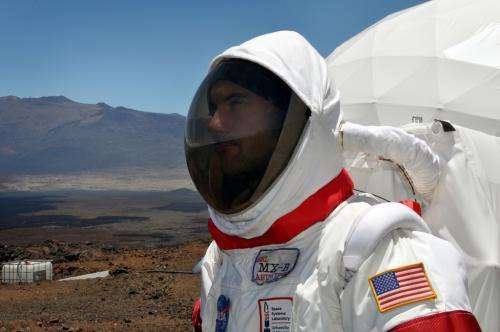Second HI-SEAS Mars space analog study begins

A new space odyssey began tonight as the six crew members of the new Hawai'i Space Exploration and Analog Simulation (HI-SEAS) mission entered their remote habitat on the first night of a four-month-long journey.
Under a dark night sky on Mauna Loa, commander Casey Stedman closed the simulated air lock behind the crew, sealing the habitat and cutting off all physical contact with the outside world for the next 120 days.
But while the outside world is locked away, the inside world will be closely monitored.
Using surveillance cameras, electronic surveys, crew member diaries and other sources, researchers from the University of Hawai'i at Mānoa will be keeping an eye on the crew. Researchers are tracking group cohesion and a wide range of cognitive, social and emotional factors. They are particularly interested in how technical, social, and task roles within the group evolve over time and how they affect performance.
It's all part of NASA-funded research to understand how teams of astronauts will perform during isolated, long-duration space exploration missions, such as those that will be required for human travel to Mars.
"Our tools and technology for space exploration are very good, but as a human race we still must contend with the 'soft side' risks of space travel," said Kim Binsted, associate professor at UH Mānoa and principal investigator for HI-SEAS. "The risks are greater the farther we hope to explore and the longer we have to keep people in space. We need to determine the best way to pick and train a crew with the right psychological makeup and supports to deal with the pressure. We also need to understand how ground crews can best assist astronaut teams that are operating under a high degree of autonomy over time."
It takes an unmanned spacecraft between 150 to 300 days to travel between Earth and the red planet. Scientists estimate that a manned journey to Mars will take around three years to complete round-trip.
NASA believes that different emotional and psychological factors might be more important for longer duration trips.
In June 2013, NASA awarded UH Mānoa $1.2 million to support three space analog missions over the next three years: four months (this one), eight months, and one year in duration, respectively. The new research follows a successful HI-SEAS food study conducted last year.
The HI-SEAS crew members will be living in a solar-powered dome that is 36 feet in diameter. The first floor of the habitat has a kitchen, dining area, bathroom with shower, a lab, and exercise and common spaces. A second floor loft features six tiny bedrooms and a half bath.
Special care has been taken to ensure the integrity of the space analog environment. For example, crew members experience a 20-minute communications delay whenever they make contact with the ground crew, just as astronauts would when Earth and Mars are at their farthest apart. Likewise, crew members will suit up in mockup spacesuits whenever they step outside of the habitat. These "excursions" will be modeled after extraterrestrial surface explorations such as those conducted during the Apollo missions to the Moon.
Provided by University of Hawaii at Manoa




















